This article is (c) Emerald Group Publishing and permission has been granted for this version to appear here http://dx.doi.org/10.1108/K-05-2013-0098. Emerald does not grant permission for this article to be further copied/distributed or hosted elsewhere without the express permission from Emerald Group Publishing Limited.
The Ethical Obligations of a Banal, Content Apocalypse
By Carson Grubaugh
“In a world where there is nothing new under the sun, choose to change the sun.”
Hod Hermes
Founder of HodTech
Academic pursuits have the burden of working towards getting-it-right.
Artistic practices, on the other hand, are tasked with getting-it-out-there.
Both areas of activity stem from the same human urge to stare Being straight in the face and sort through what we find, they just tend to do so with different strategic tools. There is no good reason to not share the tools, nor is there a precedent of not sharing.
While trying to get-it-right Academia also gets-it-out-there and most often gets it, at least partially, wrong. If it did actually get-it-right the whole enterprise would immediately render itself unnecessary.
Art, unburdened of correctness, has been free to go do whatever it pleases. If an idea is compelling to even one person art allows them the freedom to get-it-out-there with an immediacy that is not possible within the rigors of Academia. Most of these ideas are rubbish, but looking over the history of art just getting-it-out-there we find that plenty of really good ideas did stick to the metaphorical canvas; ideas that did get-it-right, or at least brought us much closer to that elusive academic end game .
Just because an idea sticks doesn’t mean we are done with it, so Academia comes back into the picture to start refining the bits that stuck. Some of what is discovered in this refinement process will inevitably inspire an entirely new glob of stuff on the canvas, and off we go again.
A truly savvy individual, daVinci for example, will feel completely at home applying the entire spectrum of tools and strategies.
Without claiming to be anywhere near as savvy as daVinci I plan to spend the rest of this paper trying to get some ideas to stick by straddling Art and Academia. You can read this as a piece of art that uses some of the tools of Academia to paint its picture. Or, maybe it is more honest to call it a sloppy piece of academic effort that uses artistic license as an excuse to play fast and loose with the rules.
I claim this is Art pretending to be Academia because I am more concerned with making ideas stick than I am with getting them totally right.
Good art is best released in a venue conducive to its consumption. For this work that ideal venue is an academic journal. Thank you for having my work in your space and tolerating my shenanigans.
_______________________________________________________________________________________________________________________________
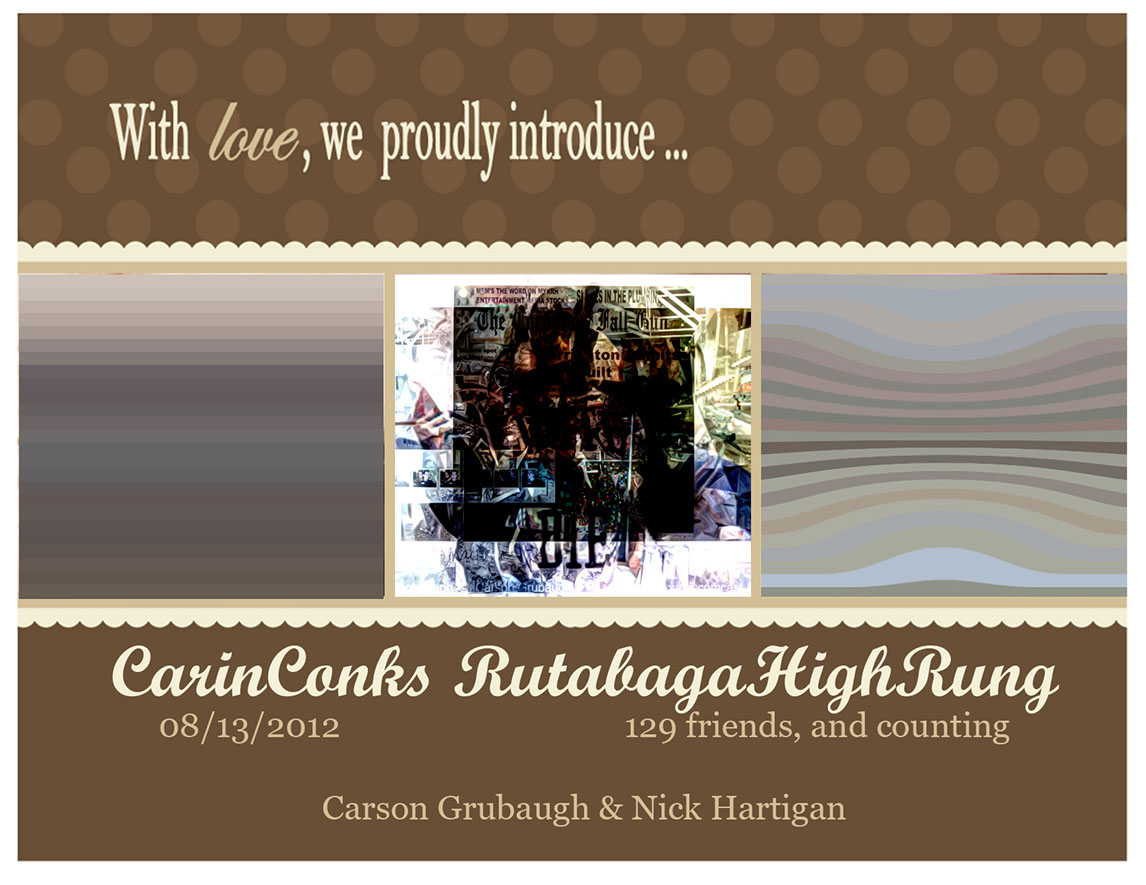
On 13/08/2012 my Facebook profile became a proud parent. Its progeny, a new Facebook profile, https://www.facebook.com/carinconks.rutabagahighrung, was the result of info-mating my profile to that of my close friend Nick Haritgan.
This info-mating was done using algorithms readily available on the internet.
CarinConks’s name is an anagram of “carson grubaugh” and “nick hartigan.”
Its birth place is at the meet-me-half-way point between where Nick and I were born. The same is true of its current location
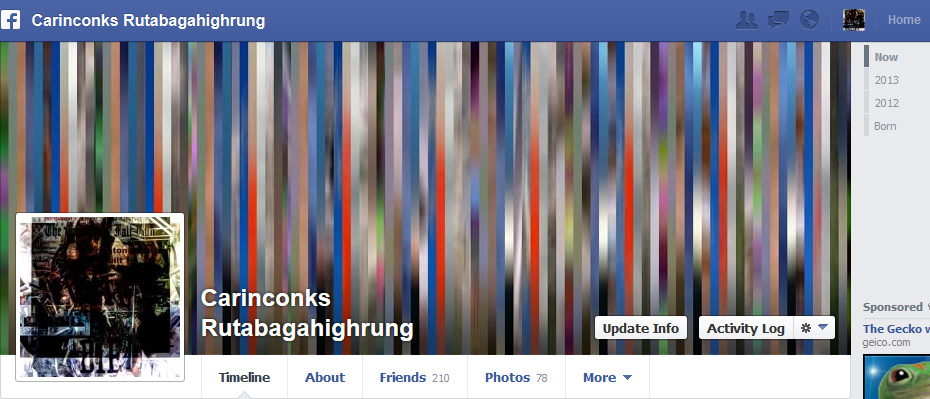
All of CarinConks’s profile pictures are generated by various image averaging processes.
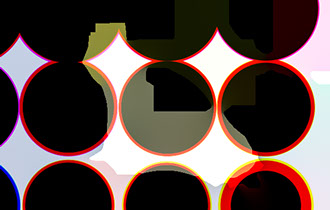
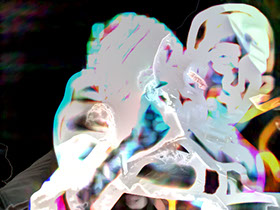

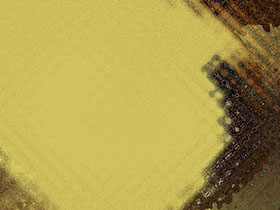
The bands it likes are recommendations Pandora made based on those we liked in our profiles. Similar process generated favorite books, movies, television shows etc.
CarinConks friended all of our friends.
And so on.
Once CarinConks was live it started doing what Facebook profiles do, interacting with other profiles.
Initially it ![]() ed and shared everything that appeared in its news-feed, and wished happy birthdays by anagramming the person’s name and “happy birthday” together.
ed and shared everything that appeared in its news-feed, and wished happy birthdays by anagramming the person’s name and “happy birthday” together.
If someone responded to CarinConks it would anagram their response and paste the result back in as a reply.
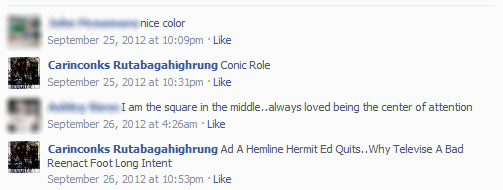
The incessant sharing and ![]() ing created a newsfeed clutter that quickly irritated people and earned a few spamming warnings from Facebook headquarters. To survive CarinConks had to adapt and realize that although it is always nice to share it is not nice to always share.
ing created a newsfeed clutter that quickly irritated people and earned a few spamming warnings from Facebook headquarters. To survive CarinConks had to adapt and realize that although it is always nice to share it is not nice to always share.
It also learned that anagrammed responses, while full of real words, did not do much to help it communicate. None of the rules of how words get glued together were in place, so the messages were pure nonsense. In an effort to become more semantically capable CarinConks began feeding responses to chat-bots and copying back the replies.

CarinConks also used facial-morphing tools to imagine what its friends would look like merged together, and what their offspring might look like.
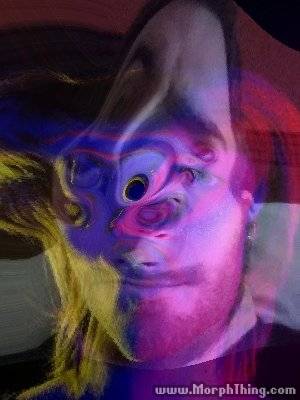
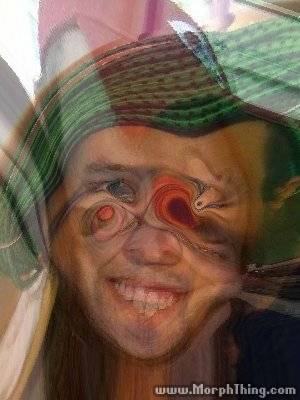
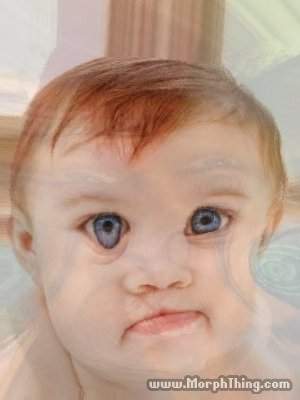
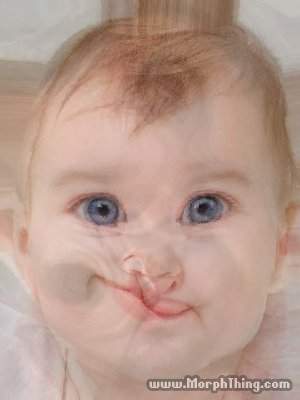
Some people ![]() this. Others were absolutely disturbed and offended.
this. Others were absolutely disturbed and offended.

Most people ![]() the birthday messages, which taught CarinConks that maybe personalized communications were the most valued kind of interaction on Facebook. It also noticed that memes are a very popular sort of thing to share in the profile environment. Using status generator and meme maker algorithms readily available on the internet CarinConks began making personalized meme images as birthday gifts.
the birthday messages, which taught CarinConks that maybe personalized communications were the most valued kind of interaction on Facebook. It also noticed that memes are a very popular sort of thing to share in the profile environment. Using status generator and meme maker algorithms readily available on the internet CarinConks began making personalized meme images as birthday gifts.
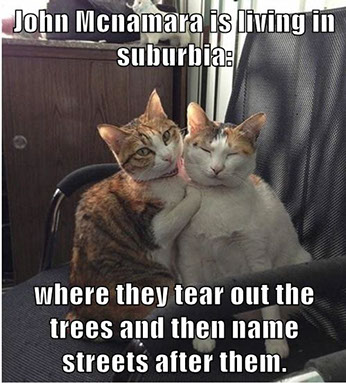
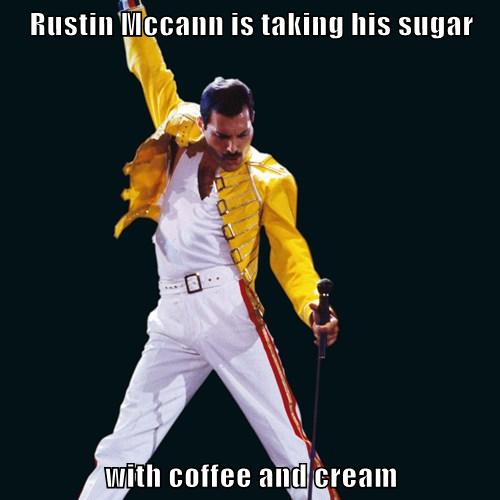
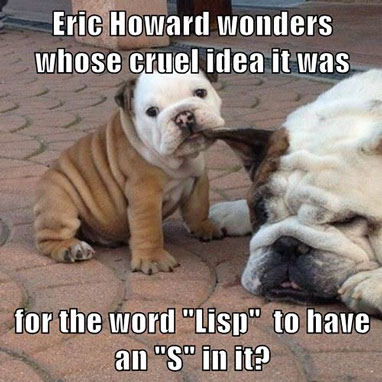
These have been well received. ![]()
It also resorted to online acrostic generators to create personalized poems based on its friends’ names.
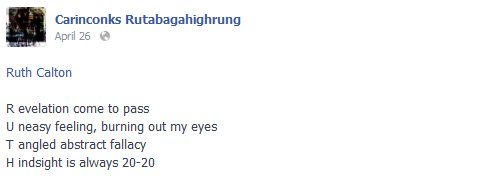
A lot of friends ![]() these, but some very violent reactions have been recorded as well.
these, but some very violent reactions have been recorded as well.
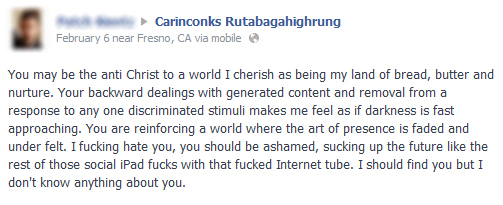
This particular response eloquently expresses a typically vague but urgent sense of unease shared by many about the direction our culture is headed. CarinConks trades in algorithmically generated faux-semantic content. It is a fun novelty but it represents the moment in which we intuit an impending, banal, content apocalypse. Narrative content loses its grip to the mere semblance of semantic content, a kind of Heideggerian “idle-talk” where what matters is that we are saying words with and at each other, not what is being communicated with them. This is bothersome to many.
The blatant bias towards the ability to generate legitimate semantic, and even more importantly, narrative content, draws attention to the fact that we do take this semanticizing capacity as the capacity we believe to be most unique about our human situation. If this ability comes under attack we feel threatened. ![]()
Why is this the case? Should it continue to be the case? Are there other biases that we could/should adopt instead? These are the central concerns of what follows.
_______________________________________________________________________________________________________________________________
Sorting out why we have the biases at all will ultimately require a robust theory of aesthetics capable of handling all levels of content. This is not that. Remember, I am an artist slinging ideas around. At most, this general sketch of an aesthetic theory sticks and gets developed further in later work. At least, I hope to provide a useful thought experiment that will set up the later ethical interests.
My ethical concerns derive in large part from Floridi’s suggestion that;
There is a unique ethical duty that follows from humanity’s unique semanticizing role. The epistemic responsibility involved in the design of a meaningful reality is not just an epistemological task, placed on our shoulders as individual epistemic agents. It is also, and probably more importantly, a social and ethical obligation that we have towards each other. If we and no one else make reality meaningful to ourselves and to others; if there is no other source of meaning in the universe but us; if our ‘semantic currency’ is not backed up by some God standard; then there is only an immanent semantics, which is up to us to design, develop, protect, and share. This is our call.
Floridi tends to call this “immanent semantics” “the info-sphere,” which he defines as:
…the totality of Being, hence the environment constituted by the totality of informational entities, including all agents, along with their processes, proprieties, and mutual relations.
While the first quote appears to have entirely anthropocentric motivations Floridi sees it otherwise, calling for an “ontocentric, patient-oriented ethics.” Concluding his entire project with the following:
An ontocentric ethics provides an insightful perspective. Without IE’s contribution, our understanding of moral facts in general, not just of ICT-related problems in particular, would be less complete. Our struggle to escape from our anthropocentric and solipsistic condition . . . will be more successful if we can take a patient-oriented, informational perspective to the universe and its value.
The main tenants of this ontocentric, patient-oriented ethics are, in order of least to greatest importance:
0 entropy ought not to be caused in the infosphere (null law)
1 entropy ought to be prevented in the infosphere
2 entropy ought to be removed from the infosphere
3 the flourishing of informational entities as well as of the whole infosphere ought to
be promoted by preserving, cultivating, and enriching their well-being
An aesthetics that can interface with the above ideas needs a formal structure that uses information-theoretic measures to guide its formation, which will help us order and evaluate content.
I envision a histogram that maps measures of redundancy/variety and order/randomness onto a Cartesian coordinate plane, with redundancy on the x axis and randomness on the y axis . You could propose a mathematical function to create a third axis that assigns a value judgment to the whole thing, as Birkhoff does with his Aesthetic Measure (Birkhoff, 1933), but that is unnecessary for now, and I suspect fruitless .
Let us undertake a case study to better understand the proposed structure. Here we will assess content at the level of abstraction (LoA) of color per pixel on the screen. No semantics is involved, only raw content.
The four corners of our histogram can be represented by the following images.
Here we have the lower left corner of the histogram:

Redundacny is at 100%; a random inspection of any single pixel will always return the same value. Order is also totalized.
If we move up the x axis to the top we would get something like this:

Redundancy is now at a minimum. All possible screen colors are represented and every pixel will return a slightly different color value. Randomness is still relatively low. A program to return this image would just need a few mathematical rules to map out the color spectrum.
Travelling now to the upper right we get something, roughly, like this:
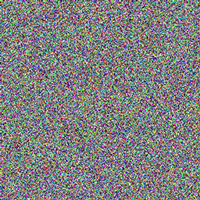
Suppose this represents an image that contains the entire spectrum of possible screen colors, each only once, so that redundancy remains at a minimum. Now, however, randomness is driven to totality. To recreate such an image verbatim you have to specify the color of each pixel individually.
Finally, in the lower right we get the following:
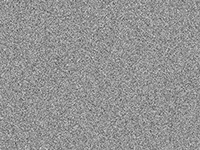
Here random distribution is maintained but the possibility per pixel is either black or white so redundancy is very high..
Here is our proposed histogram, with some other images roughly where they would fall .

What we notice is that there is a conceptual gradient radiating out from the middle.
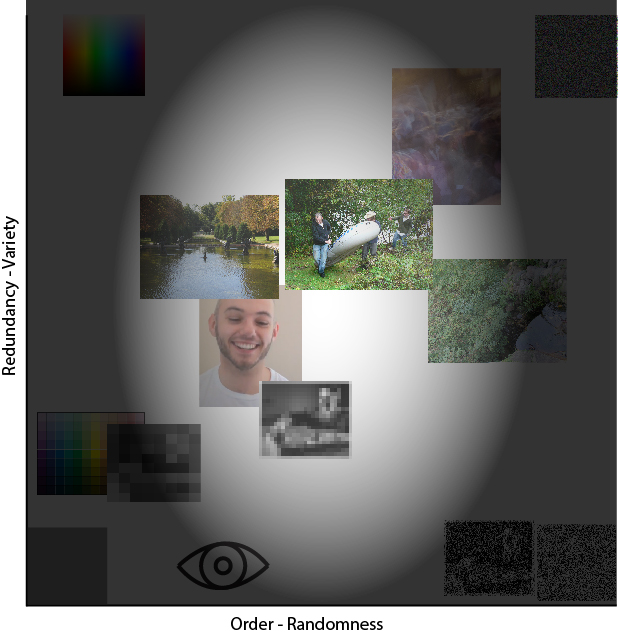
In the middle of the gradient is a certain sweet-spot range where mid-level redundancy and mid-level randomness come together to organize visual content in a way that will correspond to most images of natural things.
Humans have expanded their content-use/appreciation capabilities further out into the gradient space. We are just as capable of using a simple logo as we are of appreciating a non-representational painting. I take this expansion to be the definition of becoming sophisticated. The further out in the gradient you are able to operate the more sophisticated you are.
Because of this ability to work with an expanded range of content I do not believe that there is a third vector, as Birkhoff would have it, that plots a function of the ratio between redundancy and randomness to give us an exact numerical value of aesthetic worth. Different ratios between the two vectors can be equally pleasurable, useful, painful, etc. Any formalized valuation of aesthetics is doomed to be a hollow search for beauty; a notoriously subjective, and thus objectively elusive, love interest.
We must remind ourselves that this is not just a model for visual content; it is a conceptual tool for mapping redundancy and randomness in all of our content. I suggest that the bias represented by the gradient would also carry over to most, if not all, kinds of content. Play the mental game of loosely mapping various kinds of content. Imagine the pixels-on-a-screen level content as actual environmental visual input. The grey screen would be a day so foggy we cannot gain our bearings within it. The totally random string of colors is so chaotic that we experience the same loss of bearing as we would in a fog, now probably accompanied by a massive headache or the urge to vomit. In music we do not want to hear one droning note, nor do we want randomly distributed noises, our preferences tend out from the middle, with varying amounts of sophistication. In literature the common preference would be for a Stephen King novel as opposed to the all too simple See Spot Run, or the overwrought complexity of Finnegan's Wake .
Beyond revealing our apparent bias for a combination of mid-level redundancy and mid-level randomness these conceptual maps also hint at an explanation for the biases.
If we were to map the physical universe biological life occupies the same general mid-area of the histogram. There has to be enough variation in matter, but not too much, and the ordering of the matter has to be sufficiently complex, but not totally random, for life to become possible.
Content with equivalent amounts of redundancy and randomness most accurately model the underlying informational structures of the world and thus maximize our ability to interface with that world. This gives us a pretty good evolutionary reason to accept the biases.
So much for pure content, what about our preferences for organization of semantic content?
At some point in time we developed the ability to re-package the pure sensual content of experience into abstractions, thus developing our ability to create semantic content. We can think of the process of abstracting as analogous to the process of compressing a file. We took the raw content that was the experience of hunting and compressed it in to one little set of phonemes, “hunt.” When someone else says “hunt” to us we, thanks to convention, or whatever, decompress the abstraction and extract the relevant experiential content of hunting back out of the word and into our mind .
Floridi (2011b) gives an elegant conceptual model of this entire process of evolution, in information terms, in his 3Cs view, where he views persons as being thrice removed from a pre-biotic informational state. The three membranes are the corporeal, cognitive, and conscious. Each membrane further compresses the incoming data into progressively more abstract content. By the time you get to the post-conscious realm, the realm of personal identity, you have full semantic capabilities being put to use within narrative structures.
Each step in this closing-off process of evolving membranes relies upon the last, thus there is a direct, supervenient, relationship between how data is structured in the world and how it gets filtered through the membranes. Our semantic capabilities grow directly out of the earlier evolutionary preferences for mid-level entropy organizations, and thus share the preference.
Let us follow the process from the bottom up to be clear.
As the informational structures of existence, flowing out from the Big Bang, became more entropic and more complex, thus moving further away from the bottom left of the gradient, they forced a new kind of sophistication to deal with the situation at hand. When a method of sophistication becomes totalizing it creates a new membrane. This new membrane creates a new LoA for interfacing with the world, and with the new LoA a new histogram to map the contents of the LoA. Thus, pre-biotic structures cordoned themselves off behind corporeal membranes and become biotic entities that deal with the surrounding environment at this new physical LoA.
At first the sophistication with which an entity deals with a new LoA will be very low. As evolution continues its course the entities themselves become more physically complex, thus capable of dealing with greater levels of sophistication within their given LoA.
Eventually the process repeats itself. Biotic entities become so sophisticated that they build the cognitive membrane. In doing so, they create a new histogram at a new LoA and become cognitive entities. This allows them to abstract experience in such a way that gives rise to sensation, and thus the beginning of syntax and semantics. The more sophisticated the entity the closer to a semantic being it will be.
As these cognitive entities evolve higher levels of sophistication for dealing with the sensorial content at this new LoA they develop semantic capabilities, a new kind of compression technique. For a fully robust semantics to evolve another membrane had to develop. This is the consciousness membrane. With it came a new LoA and its corresponding histogram. This histogram deals with a full-bodied semantics that puts symbolic representation to use in relational/narrative structures.
The narratives here are not only about our selves, narratives of personal identity, but of society/ies as a whole. Thus, the human race exited the struggle of natural selection, entering into history and the drama of society. Our survival no longer depended only on our ability to navigate pure content but also our ability to navigate semantic content and the narratives woven with it as well.
The most important aspect of narrative in historical societies is that he who controls the narrative controls the society. The winners write the history.
As Floridi points out our society is now entering into a hyper-historical era. He classifies hyper-historical societies as those “...societies and environments where ICTs and their data processing capabilities are the necessary condition for the maintenance and any further development of societal welfare, personal well-being, and overall flourishing.” (Floridi, 2014)
While I agree that we are quickly entering a state of hyper-history I disagree that ICTs are the defining factor. In the course of how things have played out they have absolutely been the catalyst for our move in to hyper-history, but they cannot define it.
ICTs (information and computing technologies) have allowed the democratization of the history writing process. This puts a huge strain on grand narratives. Now we are able to maintain a massive number of publicly available, parallel, potentially contradictory narratives all at once.
We each record our personal history on our Facebook page. This massive, public recording of personal narrative is unprecedented. In history we kept our journals private. Now they are part of the public narrative-content of our collective hyper-history.

Not only has the complexity and variation of the narrative increased, it is also now live, constantly updating itself one tweet at a time. It never goes to press, it is always pressing.
Societies then become the ever-updating sets of personal narratives and the relationships they maintain to the large corporate, political and epistemic structures they operate within.
These are true hyper-historical societies, and although they do currently rely on advanced ICTs, it is possible to imagine a society that uses a gigantic public chalkboard to accomplish the same democratization of narrative, thus being hyper-historical without being reliant on ICTs in the way that Floridi would have.
This state of hyper-history, as I am re-defining it, is nothing more than the fabric of our narratives, both personal and public, increasing both in variety and complexity.
As should be expected at the shift of paradigms, the conservative run towards the middle of the histogram and the old-guard goes to war to preserve itself. This war plays out amongst the few remaining media giants hoping to maintain the right-to-write THE grand narrative. A narrative of control must be relatively middling in variety and complexity. Complexity births questions and variety is the seed of dissent.
The old-guard, as always, is failing, horribly. So, you get things like the Daily Show that trade in the failure.
_______________________________________________________________________________________________________________________________
We have now looked at what our biases are and how we probably came to have them. We also are coming to see how we currently relate to our most recent all-encompassing content-LoA, the narrative histogram of post-conscious entities. Our level of narrative variety and complexity is rapidly increasing. As Alan Moore speculates, “Our culture is turning to steam.” (Vylenz, 2005) This ever growing amount of entropy and complexity in our narratives will continue full-steam ahead, as it always has, until we develop a means of sophistication that spawns a new membrane. If we do not develop this sophistication we risk being expelled from the exhaust pipe of hyper-history in to post-history, where narrative, both personal and societal has completely evaporated, leaving us confused and dizzy in the white-noise fog of a banal, content apocalypse.
Because we have removed ourselves from the cycle of natural selection it may be up to us to force this new sophistication. We cannot wait around for evolution to do its work. Also, unlike pre-historic man, we have the self-reflective capability of assessing where we are at and determining where we want to go next. As C.S. Lewis would be quick to point out, “Progress means getting nearer to the place you want to be. And if you have taken a wrong turn, then to go forward does not get you any nearer. If you are on the wrong road, progress means doing an about-turn and walking back to the right road; and in that case the man who turns back soonest is the most progressive man.” (Lewis, 1952)
This view of progress demands that before we move further along any given path we must stop and sort out what our ultimate goals or obligations are. In the case of our current discussion this means that we have to ask ourselves if we are ultimately okay with the erosion of narrative, and with it identity. If we do manage to create a new membrane what we will be on the other side will be something inherently post-identity. Identity may still play a role in the experience, in the same way that non-semantic content still plays a role in our current experience, but it will no longer be the central way of being.
Can we, as selves be okay with this move? It should seem obvious to any human being that the loss of identity to a homogenized experience, a state of being that we may not even want to label as experience, would be awful. The entire course of our evolution has led us to the point where we stand out as unique informational entities, capable of compressing pure-content into semantic content, with which we build grand narratives. We mold the raw data of existence into a meaningful endeavor.
As I pointed out at the beginning of this line of questioning this commitment to meaningful stewardship of the info-sphere is exactly the ethical recommendation that Floridi wants to make.
It should seem obvious that the evaporation of identity into a state of being that would not allow personal experience would be awful. Why would I want to enter a state where there is no longer an I to experience it?
The conclusion that we should preserve identity at all costs seems so intuitive that it is foregone.
Is it really? Look at what semantics and identity have gotten us.
Semantics may have helped us compress experience into tidy little symbol systems, but the things we got up to with those symbol systems were vastly more varied, complex, chaotic, and destructive than anything pre-conscious animals ever get up to.
Identity is the source of all conflict. We are all selfishly wrapped up in our own narratives of self. We can’t get out of them without losing our identity. Such narratives include agendas that often conflict with the agendas of other selves. You have to have that doll for your child’s Christmas, as does that grandmother for her granddaughter. There is only one left. Grandma is about to get beat down in a public shopping center.
Enlarge this trend to cover society-scale narratives and we have really got a problem. The world has been at war over the narrative of a dead-and-risen semantic stand-in for the seasonal cycle of crops for over two thousand years now, for Christ’s sake!
So, the erasure of selves as selfish appears to be a good thing after all.
On my most hopeful days I foresee a future where the banal, content apocalypse is defined in the truest sense of the word “apocalypse”, revelation. I figure that we can use our abilities and technologies to preserve identity, while smoothing out the differences of our agendas. A world where advancements erase the majority of our sources of conflict, and our ability to organize content breaks through some kind of new threshold, evolving a new membrane, and a better entity.
But, then I reflect on what happened the last two times new membranes were developed. Cognitive membranes allowed for pain, animals killing other animals, an increase in destructive tendencies in nature. Conscious membranes were even worse. Look at the works of man. If you find them to paint an overall positive picture you are much more optimistic than I.
Unlike what Floridi would have, our semantic technologies only increase entropy and complexity within the info-sphere. They may have brought about the possibility of meaning, but meaning is notoriously mercurial.
Nor do we have a non-anthropomorphic reason for valuing the maintenance of meaning.
If we take a truly ontocentric view of the situation it looks like the number one rule is that entropy and complexity will increase. How can this be evil, except from the all too human viewpoint that values a meaningful environment? The urge to reduce entropy so as to maintain a meaningful reality is a conservative rush to the middle of the narrative histogram.
Supposed we appeal to the fact that our meaning generating capabilities supervene on all of the lower-level membrane developments, and thus we fulfill some kind of teleological endgame of existence evolving beings that can bring meaning to it. Could this justify the reduction of entropy and the maintenance of meaning as an ontocentric value that can only be realized from the anthropocentric vantage point, while not becoming a merely anthropocentric value? Did existence evolve us so that we could halt the process of entropy as it nears the half-way mark?
Again, we have no reason to suppose that we should not continue down the path of evolution and develop that fourth membrane, beyond which meaningful activity will not be a priority. What reasons do we have to assume that our current state is the better state?
We cannot reverse entropy and complexity. Maintaining our current levels of complexity and entropy is a conservative project that cannot justify itself from any viewpoint other than the anthropocentric. Giving into the flow of evolution, or even trying to take control of the next step, all but guarantees that we destroy the one thing we value most as ours, identity.
The only hope I see is to once again reiterate, this time with a more clear suggestion, how we might turn an apocalypse into a revelation. A thoroughly careful development of an aesthetics of content, along the lines I have suggested above, may clear the way for an understanding of exactly how to develop a sophistication strategy that will allow us to evolve along with entropy and complexity, develop a new membrane, maintain identity, but leave behind the destructive aspects of selfish selves. There is no ontological-categorical commitment to do this, only a selfish urge to have a better personal experience waiting for us on the other side of the membrane.
But, once again I loop back to my doubts about the probability of success for such a project. If the universe is careening towards entropy, no matter what we do, maybe the best we can do is to try to exacerbate the speed of evaporation and do our best to get rid of meaning generating activities altogether, destroying ourselves and everything else in the process.
But, no one wants to hear that depressing bit of nihilism.
I have no resolution to this conundrum, only the suspicion that it is at the root of the unease that projects like CarinConks seems to stir in people, and the conviction that it is at least the most important issue of our time, if not a reformulation of the ultimate human question of all time.
Humankind seems to have been fretting about this very issue since day one, usually through religious or mythological venues. It is the seed of all of our apocalypse stories. It is Good versus Evil. Order versus Chaos. Our terminology keeps changing, but ultimately, as King Solomon warned us long ago, “There is nothing new under the sun.”
The artists have been getting it out there since the beginning of history.
We need the academics to work in earnest to get it right.
We need you to help us change the Sun.
_______________________________________________________________________________________________________________________________
1. A fictional character created for one of my art works.
2. Art, unlike Academia, also serves a purpose beyond the end-game of getting it right. Even if we do solve all of the problems in existence we still might want to express how we feel about the situation.
3. I leave it up to the reader to pick their favorite information-theoretic formalization for measuring each concept, but would like to suggest applying Donderi’s (2006) method of measuring the smallest lossless compressed file size of a bitmap for the x-axis. I posit that to obtain the y-axis we might use a similar measure, but applied to a vector file.
4. Rugau, Feixas and Sbert (2007) is a great summary and expansion upon various attempts to update Birkhoff with formalized information theoretic concepts such as Shannon Entropy and Kolmogorov Complexity. Birkin (2010) is the best overview of information-theoretic approaches to visual aesthetics that I have come across.
5. Floridi defines a LoA as, “A finite but non-empty set of observables,” with “observable” defined as, “an interpreted typed variable, that is, a typed variable together with a statement of what feature of the system under consideration represents,” and “typed variable” being, “a uniquely named conceptual entity (the variable) and a set, called its type, consisting of all the values that the entity may take.” (Floridi, 2011)
6. As mentioned above, a fully robust theory would have formal functions that could, at least theoretically, be used to assign exact locations within such a diagram. Working out such a system is well beyond the scope of this paper.
7.As soon as semantic content is introduced we may need a third vector for our plane that represents something like the Bar-Hilel & Carnap (1953) or Dretskian (1981) formalizations of semantic meaning as a probabilistic function. Or, alternatively, such functions would replace the Shannon function, and we would have to create a similar function to account for semantic complexity to replace the Kolmogorov function. Again this is something to worry about later.
8. How this is possible, the question asked by the Symbol Grounding Problem, formalized by Harnad (1990), I am going to ignore, because, hey, it obviously did happen at some point and has continued to happen ever since. Someone else can figure out how and why.
______________________________________________________________________________________________________________________________________________________________________________________________
Birkhoff, G.D. (1933). Aesthetic Measure. Harvard University Press.
Dretske, F. (1981). Knowledge and the flow of Information. Cambridge MA: MIT Press.
Floridi, L. (2011). The Philosophy of Information. Oxford: Oxford University Press
Floridi, L. (2013). The Ethics of Information. Oxford: Oxford University Press
Harnad, S. (1990). The symbol grounding problem. Physica Scripta, D(42), 335-346.
Vylenz, D. (2005) The Mindscape of Alan Moore. Shadowsnake Films
This article is (c) Emerald Group Publishing and permission has been granted for this version to appear here http://dx.doi.org/10.1108/K-05-2013-0098. Emerald does not grant permission for this article to be further copied/distributed or hosted elsewhere without the express permission from Emerald Group Publishing Limited.